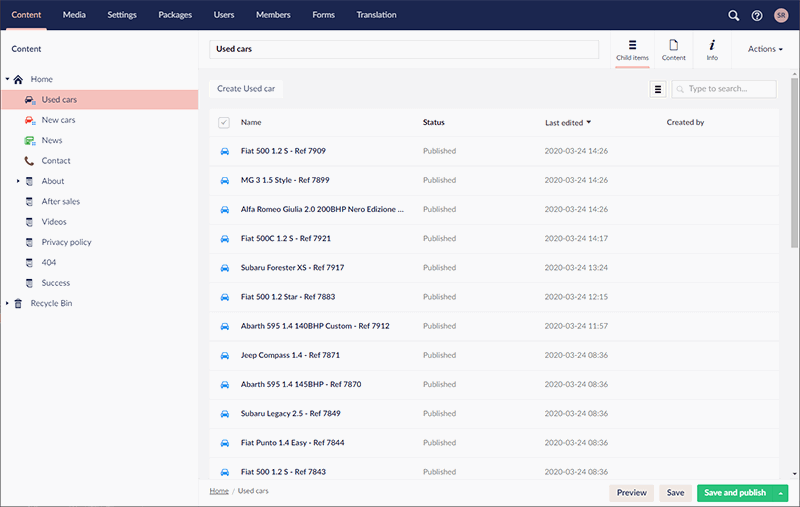Why we choose to use the Umbraco CMS



An insight into our CMS of choice, why we use it, and why you should consider it for your next web development project.
When it comes to creating a website, you’re going to want to build it on a Content Management System (CMS) so you are able to manage the content of the website in-house. There are many choices, and it can seem quite overwhelming when deciding. Services such as Wordpress, Squarespace & Wix have great DIY website builders. These services would suit websites that require minimal content management, such as a blog or a basic brochure website.
Then there are more advanced solutions such as Sitecore, which is used by many government agencies with an emphasis on using enterprise level software built on Microsoft technologies and the security benefits that come with that. The downside is that most advanced solutions come with a hefty annual licensing fee.
Then there is our good old friend, Umbraco. Umbraco sits somewhere in the middle of these two solutions, and has many benefits of both. Let me explain.
What is Umbraco
Firstly, let’s talk about Umbraco. Umbraco is a free open-source content management system built on the Microsoft stack of technologies. Unlike most content management systems, which come pre-installed with a load of features and plugins you just don’t need or use (which just makes it confusing and a pain to navigate). Umbraco is effectively a blank canvas which is intended to be tailored to suit your website's needs, which in turn creates an intuitive and pain free experience for content editors.
Perfect for publishing content
As I’m sure you’re aware, content is the essence of a website. A regular stream of good quality content is what Google deems as a necessity in ranking your website in the SERPs (Search Engine Results Page). So it seems only logical to use a content management system that makes publishing and managing content seem like a breeze.
Umbraco displays your websites pages in a tree structure, nicely nested in a logical way. This is a welcome feature of the Umbraco CMS, as most content management systems display pages in one big list which makes finding content much harder.
With Umbraco you can easily set up users with different permissions to manage your content workflow. Jane from accounts can write a new piece of content, but Dave the MD must approve and publish it before it goes live.
The flexible CMS
Before we start any project we like to get under the skin of our clients business to understand the underlying business goals and the (sometimes) complex requirements of their customers. Therefore, we require a CMS that has the flexibility to deliver on these requirements.
Enter Umbraco. As we are dealing with a blank canvas when working with Umbraco, we are able to create a bespoke user experience tailored to the requirements of the business.
Say for example your business is a car dealership, and you need to manage your used car inventory, we can easily create a simple, intuitive interface tailored to that particular task, managing your used car inventory. Simple, easy to use, and no headaches.

No job is too small or too big for Umbraco. The vanilla nature of it allows you to make things as complex or as simple as they need to be. Umbraco even has ecommerce capabilities, so it truly can cover all bases.
Umbraco vs Wordpress
There always must be a comparison to Wordpress. Simply because it is the most used content management system on the web. According to W3Techs around 35% of all websites are powered by Wordpress. This statistic is not hard to believe as they have made it so simple to spin up a basic Wordpress website.
But does that mean it is the best? No. Not by a long shot.
On the flip side of Wordpress being the most commonly installed CMS on the web, it is also the most hacked. With 90% of all websites that are hacked being developed on Wordpress.
Umbraco was designed to be a CMS, whereas Wordpress was originally designed as a blogging platform, which evolved overtime into a CMS.
Wordpress is heavily reliant on installing plugins to meet the desired requirements of a website. This adds bloat to the website, which in turn can result in poor performance. Being very plugin focused it is also a bit like a ticking time bomb. You could use the analogy of stacking playing cards, where adding one more card could topple the whole stack.
With Umbraco on the other hand, it is simple to build out functionality from the ground up. This enables the website to be in a constant stable state without having to worry about a plugin update causing the entire website to break.
We don’t want to completely take Wordpress to the cleaners here. In fact, we’d even recommend it to a business who wanted to get a basic website up to showcase their service offering. But when you want to add any sort of functionality to a website, you need to consider the stability and longevity of your investment.
As the saying goes, "Measure twice, cut once".
Our Umbraco expertise
We have over a decade of experience developing hundreds of websites on Umbraco. If you’ve got a web development project and think Umbraco could be a good fit for your business, we’d love to have an informal chat and demonstrate the capabilities of Umbraco. Get in touch and we’d be happy to help.




